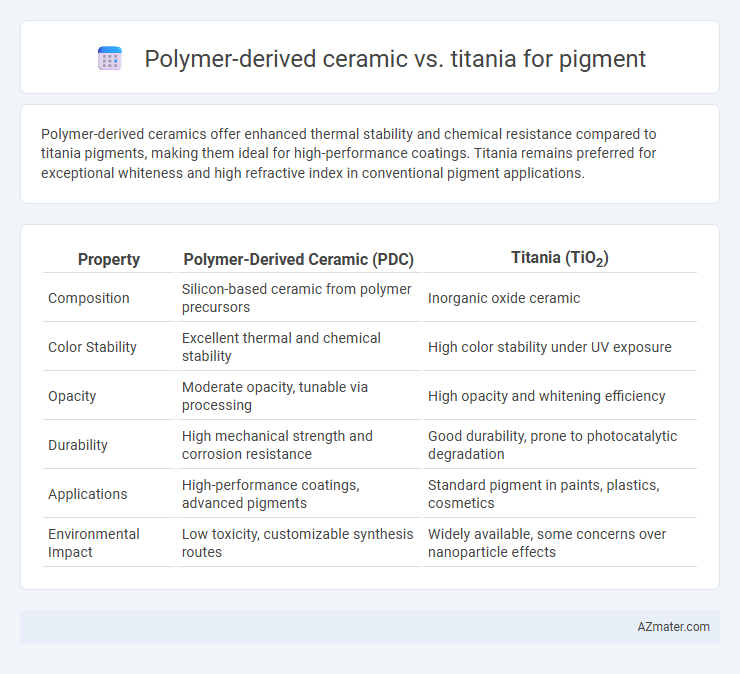Polymer-derived ceramics offer enhanced thermal stability and chemical resistance compared to titania pigments, making them ideal for high-performance coatings. Titania remains preferred for exceptional whiteness and high refractive index in conventional pigment applications.
Table of Comparison
| Property | Polymer-Derived Ceramic (PDC) | Titania (TiO2) |
|---|---|---|
| Composition | Silicon-based ceramic from polymer precursors | Inorganic oxide ceramic |
| Color Stability | Excellent thermal and chemical stability | High color stability under UV exposure |
| Opacity | Moderate opacity, tunable via processing | High opacity and whitening efficiency |
| Durability | High mechanical strength and corrosion resistance | Good durability, prone to photocatalytic degradation |
| Applications | High-performance coatings, advanced pigments | Standard pigment in paints, plastics, cosmetics |
| Environmental Impact | Low toxicity, customizable synthesis routes | Widely available, some concerns over nanoparticle effects |
Introduction to Pigment Materials
Polymer-derived ceramics offer superior thermal stability, chemical inertness, and customizable microstructures compared to conventional titania pigments, making them ideal for advanced coating applications. Titania pigments, primarily composed of titanium dioxide, dominate the market due to their excellent brightness and high refractive index but show limitations under extreme conditions. Advanced polymer-derived ceramic pigments enable enhanced durability and resistance to UV degradation, expanding their functionality beyond traditional titania uses.
Overview of Polymer-Derived Ceramics
Polymer-derived ceramics (PDCs) are advanced materials synthesized through the pyrolysis of preceramic polymers, offering unique advantages in pigment applications due to their tunable composition, high thermal stability, and excellent chemical resistance. Unlike conventional titania pigments primarily composed of TiO2 known for high opacity and brightness, PDCs enable the incorporation of elements such as silicon, carbon, nitrogen, and boron, facilitating tailored optical properties and color versatility. Their nanoscale structure and ability to form composite pigments provide superior durability and multifunctionality in coatings, inks, and ceramics compared to traditional titania-based pigments.
Titania: Structure and Applications
Titania (TiO2) exhibits a well-defined crystalline structure, predominantly in anatase and rutile phases, which directly influences its optical properties as a pigment. Its high refractive index and strong light-scattering ability make titania an essential white pigment in paints, coatings, plastics, and paper, providing exceptional brightness and opacity. The rutile form offers superior weather resistance and durability, while anatase is valued for photocatalytic applications, expanding titania's utility beyond traditional pigmentation.
Synthesis Processes: PDCs vs Titania
Polymer-derived ceramics (PDCs) are synthesized through polymer precursor routes involving controlled pyrolysis, enabling precise tuning of microstructure and chemical composition for pigment applications. Titania pigments, typically produced via the sulfate or chloride process, rely on the mineral extraction and high-temperature calcination to generate TiO2 nanoparticles with high refractive index and opacity. The synthesis of PDCs allows for customizable properties and enhanced thermal stability, whereas titania's conventional methods focus on achieving consistent particle size and brightness for widespread pigment use.
Optical Properties Comparison
Polymer-derived ceramics exhibit superior thermal stability and tunable refractive indices compared to traditional titania pigments, enhancing their optical performance in high-temperature applications. Titania pigment offers high opacity and brightness due to its strong light scattering and high refractive index (~2.7), but polymer-derived ceramics can achieve tailored optical band gaps and improved UV resistance. The ability of polymer-derived ceramics to maintain optical clarity and color stability under extreme conditions makes them a promising alternative for advanced pigment applications.
Chemical Stability and Durability
Polymer-derived ceramics exhibit superior chemical stability and durability compared to titania pigments due to their robust ceramic network structure, which resists degradation under harsh environmental conditions. Titania, while widely used for its high refractive index and brightness, is susceptible to photocatalytic degradation and chemical corrosion in acidic or alkaline environments. The enhanced thermal and chemical resilience of polymer-derived ceramics ensures prolonged pigment performance in demanding applications such as coatings and high-temperature processes.
Environmental Impact and Safety
Polymer-derived ceramics used as pigments exhibit lower environmental impact due to their energy-efficient synthesis and reduced emissions compared to traditional titania production, which requires high-temperature processing and generates significant CO2. In terms of safety, polymer-derived ceramics offer enhanced biocompatibility and lower respiratory risks, whereas titania nanoparticles have raised concerns over inhalation toxicity and photocatalytic activity that can produce reactive oxygen species. The sustainable manufacturing and safer exposure profile of polymer-derived ceramic pigments position them as a greener alternative to conventional titania pigments in various applications.
Cost and Scalability Considerations
Polymer-derived ceramics offer a cost-effective alternative to titania pigments due to lower raw material and processing expenses, enabling scalable production through adaptable polymer routes. Titania remains more expensive, driven by high-purity ore requirements and energy-intensive processing, limiting economic scalability in large-volume pigment manufacturing. The versatility of polymer-derived ceramics allows for customization and integration into existing manufacturing lines, enhancing cost efficiency in industrial-scale pigment applications.
Current Industrial Applications
Polymer-derived ceramics (PDCs) offer high thermal stability and chemical resistance, making them ideal for specialized pigment applications in harsh environments such as aerospace coatings and high-temperature industrial paints. Titania (TiO2) remains the dominant pigment in the industry, prized for exceptional opacity, brightness, and UV protection, widely used in automotive paints, plastics, and paper coatings. Current industrial trends show Titania's continued dominance in mainstream pigment markets, while polymer-derived ceramics carve niches where enhanced durability and performance under extreme conditions are required.
Future Trends in Pigment Technology
Polymer-derived ceramics (PDCs) offer enhanced thermal stability, chemical inertness, and tunable nanostructures, positioning them as a promising alternative to traditional Titania pigments in advanced coating applications. Emerging trends in pigment technology emphasize the development of eco-friendly, high-performance materials with customized optical properties, where PDCs enable precise control over color and durability at the nanoscale. Future research focuses on scalable synthesis methods and functionalizing PDCs to outperform Titania in UV resistance, self-cleaning surfaces, and environmental sustainability, driving innovation in next-generation pigments.

Infographic: Polymer-derived ceramic vs Titania for Pigment
 azmater.com
azmater.com